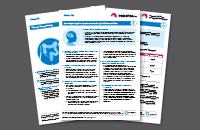 Full Guidelines
Full Guidelines
Click here to view article

 Tools
Tools


 Additional Documents
Additional Documents
Click here to see additional documents

 Endorsements
Endorsements
This Clinical Practice Guideline has been endorsed by the College of Family Physicians of Canada (CFPC).

 Calculate by QxMD
Calculate by QxMD
This guideline and KT tool(s) are available on QxMD. Click here to download the app.
This Canadian Task Force on Preventive Health Care (Task Force) guideline provides evidence-based recommendations on screening to prevent fragility fractures in community-dwelling individuals ≥ 40 years not currently on preventive pharmacotherapy. Fragility fractures result from a minor impact that would not damage normal bone. These occur due to weakened bone structure or low bone mineral density (referred to as osteoporosis).
The actual screening practice to prevent fragility fractures often relies solely on bone mineral density testing (BMD) with the possible addition of risk assessment. Fracture risk assessment tools (e.g., FRAX, CAROC) estimate the percentage risk or risk category for a fracture over 5-10 years. BMD involves dual energy X-ray absorptiometry of the femoral neck (hip) and provides a T-score (based on standard reference values) that can also be used as an element of risk assessment.
In this guideline we recommend the “risk assessment-first” screening approach which involves using a fracture risk estimation tool (e.g., FRAX without BMD), followed by shared decision making with the patient and BMD if the patient is interested in preventive treatment to lower their risk. If BMD is ordered, risk is then re-estimated by adding the BMD T-score to the calculation.
Evidence indicates that risk assessment-first screening probably reduces hip fractures and probably slightly reduces clinical fragility fractures (also called major osteoporotic fractures) among females ≥ 65 years (moderate certainty evidence). However, for younger females (<65 years) and males aged ≥ 40 years, the evidence was indirect or very uncertain and did not establish a benefit.
Acceptability of screening is high, but patients vary in the level of fracture risk at which they choose to initiate treatment. In situations of variation in patient perception of risk and treatment thresholds, decision aids could help improve understanding and adherence. Shared decision-making could improve the alignment of screening and treatment based on patient preferences.
Harms of screening include overdiagnosis (i.e., individuals correctly classified as high risk (labelled) but who would never have known they were at risk nor experienced a fracture and therefore are exposed to further assessments or preventive pharmacotherapy without the possibility of benefit) and adverse effects (AEs) of treatment (e.g., reflux) (low to moderate certainty). Rare but serious harms of atypical femoral fracture and osteonecrosis of the jaw may also be increased (low certainty evidence).
In the judgment of the Task Force, for females aged ≥ 65 years, the reduction in hip and clinical fragility fractures outweighs the potential risk of overdiagnosis (of being labelled as “at high-risk”), non-serious AEs and rare serious AEs. Risk assessment-first screening was recommended based on methods used in the randomized controlled trials (RCTs), accuracy of Canadian clinical FRAX and reported patient values. Shared decision-making following risk assessment was recommended based on the observation that patient treatment acceptability differs and the variation in clinical FRAX thresholds for BMD access observed in the RCTs. An interactive decision aid was developed to help patients consider the potential benefits and harms of preventive pharmacotherapy within their individual risk context frax.canadiantaskforce.ca.
Considering the risk of overdiagnosis (of high-risk) and small increased risks of treatment-related AEs, we recommend against screening females 40-64 and males ≥ 40 years. These recommendations are strong because there was no evidence establishing a benefit (evidence on benefits was uncertain or indirect), there was low to moderate-certainty for harms and the Task Force places a high value on not expending system-wide resources in this context.
Key Recommendations
We recommend risk assessment-first screening to prevent fragility fractures in females aged ≥ 65 years as follows (conditional recommendation, low-certainty evidence):
- FRAX: Apply the Canadian clinical FRAX risk assessment tool (without BMD). Use the 10-year absolute risk of MOFs to facilitate shared decision-making about the possible benefits and harms of preventive pharmacotherapy.
- BMD + FRAX: After this discussion, if preventive pharmacotherapy is considered, request BMD measurement using dual energy X-ray absorptiometry of the femoral neck. Then re-estimate fracture risk by adding the BMD T-score into FRAX.
We recommend against screening females aged 40-64 years and males ≥ 40 years to prevent fragility fractures (strong recommendation, very low-certainty evidence).
These recommendations apply to community-dwelling individuals not currently on pharmacotherapy to prevent fragility fractures.
No RCTs on screening intervals or upper age limits were found during our systematic review. Although some observational studies recommend intervals based on age, baseline BMD or absolute fracture risk, repeating BMD at 3-8 years did not improve fracture risk prediction. It is unknown how often rescreening eligible females should occur, however, rescreening within 8 years does not appear useful. Comorbidities and life expectancy should be considered for upper age limits.
The recommendation against screening males and younger females emphasizes the importance of good clinical practice, where clinicians are alert to changes in physical health and risk factors. Clinicians should also be aware of the importance of secondary prevention and manage patients accordingly.
How is the Task Force guideline different from other guidelines?
There are similarities but also differences between the Task Force guideline and other recommendations. The Task Force and other guidelines recommend screening females aged ≥ 65 years, however, the Task Force recommends risk assessment-first while other guidelines recommend BMD testing-first, followed by risk assessment. The Task Force recommends risk assessment–first screening for females aged ≥ 65 years, based on the methods used in the randomized controlled trials , accuracy of the Canadian clinical FRAX tool, and patient values and preferences. Risk assessment-first screening allows for shared decision-making where patients can consider preventive pharmacotherapy within their individual risk context (before BMD testing). The Task Force has developed a decision aid to help with shared decision-making (https://frax.canadiantaskforce.ca/). A risk assessment-first approach to screening females aged ≥ 65 years may reduce unnecessary BMD testing.
The Task Force recommends against screening females aged 40-64 years and males aged ≥ 40 years. Other guidelines have recommended screening males ≥65 years or those 50-64 with risk factors. However, the Task Force determined that there was no direct evidence establishing a benefit in females aged 40-64 years or males of any age and there was low to moderate certainty for harms. Additionally, screening males is not standard practice in Canada and there has been low participation (e.g., 10-15%) in screening despite the 2010 Osteoporosis Canada recommendations to screen males aged ≥ 65 years
Additional Documents
- Clinician Summary
- Excluded Studies (pdf)
- Systematic Review Protocol
- Published Systematic Review
- TFPAN Community Jury: Data Summary Report (pdf)
- Reviewer’s comments (pdf)
- CMAJ Author Podcast
- Ostéo-Pas-Rose: un terme à oublier? (Podcast from TopMF in French)
- Guideline Presentation
ECRI Evaluation Scores
ECRI Guidelines Trust scores guidelines based on their adherence to the National Academy of Medicine Standards for Trustworthy Guidelines. Find the ECRI evaluation scores for this guideline here.




